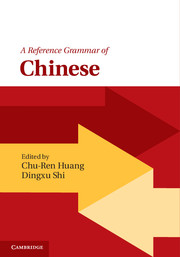Book contents
- Frontmatter
- Dedication
- Contents
- List of figures
- List of tables
- List of contributors
- Preface
- Acknowledgements
- English–Chinese term list
- Chinese–English term list
- 1 Preliminaries
- 2 Syntactic overview
- 3 Lexical word formation
- 4 Verbs and verb phrases
- 5 Aspectual system
- 6 Negation
- 7 Classifiers
- 8 Nouns and nominal phrases
- 9 Relative constructions
- 10 Adjectives and adjective phrases
- 11 Comparison
- 12 Adverbs
- 13 Prepositions and preposition phrases
- 14 Sentence types
- 15 Major non-canonical clause types: ba and bei
- 16 Deixis and anaphora
- 17 Information structure
- Appendix: Punctuation
- Bibliography
- Index
Preface
Published online by Cambridge University Press: 05 March 2016
- Frontmatter
- Dedication
- Contents
- List of figures
- List of tables
- List of contributors
- Preface
- Acknowledgements
- English–Chinese term list
- Chinese–English term list
- 1 Preliminaries
- 2 Syntactic overview
- 3 Lexical word formation
- 4 Verbs and verb phrases
- 5 Aspectual system
- 6 Negation
- 7 Classifiers
- 8 Nouns and nominal phrases
- 9 Relative constructions
- 10 Adjectives and adjective phrases
- 11 Comparison
- 12 Adverbs
- 13 Prepositions and preposition phrases
- 14 Sentence types
- 15 Major non-canonical clause types: ba and bei
- 16 Deixis and anaphora
- 17 Information structure
- Appendix: Punctuation
- Bibliography
- Index
Summary
A reference grammar is a snapshot of language in action as well as a comprehensive description of how language is used. In addition, a reference grammar attempts to describe the range of possibilities of how words and other larger linguistic units may be put together in the language, and how they can present different meanings in different contexts. Moreover, a reference grammar aids linguists in constructing theories for one language in particular, and all languages in general. A reference grammar also provides roadmaps for both language learners and teachers to navigate the complexity of learning or teaching a new language. Lastly, a reference grammar shares with all language lovers the beauty of language as a knowledge system, including the cultural heritage of the language.
A Reference Grammar of Chinese is designed with all of the above functions in mind. We are keenly aware of the challenge and constraints of containing a grammar within the confines of the book format. Hence, we worked out a solution by constructing an example corpus in parallel while drafting our grammar. This example corpus constitutes a distinguishing feature of this book. On the one hand, all the generalizations reported in this grammar are based on expert linguists’ observations of a large set of corpus data. On the other hand, when reading this reference book, a reader can refer to the example corpus (at the website http://crg.cbs.polyu.edu.hk) using chapter, section, and example numbers, so that the reader can form his/her own generalizations and/or tease out more details that could not be included in the grammar due to space considerations. Thus, the example databases allow A Reference Grammar of Chinese to be not only an evidence-based grammar, but also a grammar not constrained by the limitations of the pages of the book.
We are also fully aware of the fact that a reference grammar must refer to a familiar framework of grammar. As English is the academic metalanguage used for this book, and English grammar is the most familiar language grammar due to its largest number of second language learners, we choose to adopt and follow the framework of English descriptive grammar. In particular, we follow the structure and drafting guidelines of The Cambridge Grammar of the English Language (CGEL) as closely as possible.
- Type
- Chapter
- Information
- A Reference Grammar of Chinese , pp. xvi - xviiPublisher: Cambridge University PressPrint publication year: 2016

